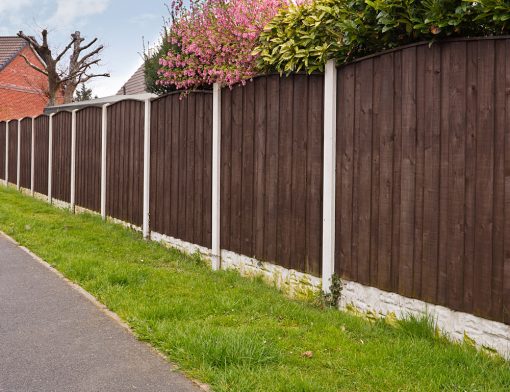Concrete vs Timber Fence Posts

Forget Anthony Joshua vs Tyson Fury. There’s one slugfest that’s had fencing contractors and DIY-ers at loggerheads for years: concrete fence posts vs timber fence posts. Some will swear by the hard-wearing characteristics of concrete. While others point to wood’s look and feel as evidence for its superiority. There’s only one way to solve the issue - a head-to-head bout for fencing supremacy. Let’s get ready to rumble!
Round 1 - Aesthetics
In terms of looks, timber fence posts create a far more natural effect than their concrete counterpart. They can be easily matched to your fence panels, creating a consistent wooden perimeter around yards and gardens. They also blend seamlessly with trees, hedgerows and wooden decking. And adding an ornate timber fence cap like the one below can add a touch of class that concrete posts can’t accommodate.
Winner: Timber

Round 2 - Durability
Concrete is as sturdy and durable a building material as you’ll find. With just a minimal level of maintenance, concrete fence posts can last for around 25 years. However, they are not immune to wear and tear. Over time, wind and rain can cause concrete posts to chip and crack. This can eventually cause interior wire reinforcements to become exposed and rust, which can significantly weaken the structure. That means there can be health and safety concerns, especially if fencing is being installed in a workplace. Timber, meanwhile, can have a long or short lifespan depending on the type of wood used - while treated spruce can last for 10-15 years, untreated spruce may need replacing in as little as 4 years. Once they begin to rot, timber fence posts can also pose a safety risk if not replaced in a timely fashion.
Winner: Concrete
Round 3 - Maintenance
Concrete fence posts require no after-sale treatment and require minimal upkeep for the duration of their lifespan. The main challenge is to ensure water does not get into the post’s foundations, as this can freeze and expand, loosening the fence post. Beyond that, you can pretty much install them and forget about them for a quarter of a century! When buying timber fence posts, bear in mind they will need treating every 1 - 2 years, depending on the type of timber they’re made from. However, it’s worth bearing in mind that even concrete fence posts will almost certainly be keeping wooden fence panels in place, which will also need re-treating regularly. So if you opt for timber fence posts, it’s just a case of incorporating them into your usual fence panel maintenance.
Winner: Concrete

Round 4 - Installation
Concrete is heavy. So installing a concrete fence post will usually require two to three people - especially if you are not experienced. Timber posts, on the other hand, are often light enough be installed by just one pair of hands (depending on the type of wood used and size of the posts). Unless you’re a seasoned professional, however, it’s still probably a good idea to have a friend help you out.
Winner: Timber
Round 5 - Security
When timber fence panels are combined with concrete fence posts, the result is a perimeter fence with a security flaw; sadly, thieves often break into gardens by sliding fence panels out of position. This can allow them access to your house, shed, garage, or even any pets living outdoors. Timber fence panels, on the other hand, can be screwed directly to wooden fence panels once installed, making them far more difficult to remove. And for added security, panels can be fixed into place using Torx head screws which can be threaded through the timber posts. This puts an extra hurdle in thieves’ way, as they would need to remove at least six screws using a special Torx head screwdriver to get just a single panel loose - not impossible, but far more difficult than simply sliding a panel out of place. Timber Fence Caps can serve as an additional deterrent, as it’s impossible to slide a panel out without first removing most caps. As a bonus, fixing fence panels into place prevents annoying rattling in the wind, and ensures panels don’t end up halfway down the street during high winds.
Winner: Timber
Round 6 - Cost
Concrete is generally more expensive than timber, though not by much. However, when you add in treatment, maintenance and replacement costs, the long-term savings probably lean in concrete’s favour.
Winner: Concrete
RESULT : Draw We have a tie! When the scores are tallied up, there’s nothing to separate the two. In the end, the type of post you choose will come down to your priorities. Are you happy to sacrifice a level of security for durability? Or are aesthetics more important to you than long-term cost?

